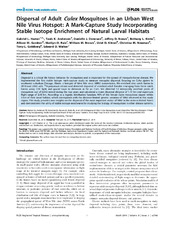| dc.creator | Hamer, Gabriel L. | |
| dc.creator | Anderson, Tavis K. | |
| dc.creator | Donovan, Danielle J. | |
| dc.creator | Brawn, Jeffrey D. | |
| dc.creator | Krebs, Bethany L. | |
| dc.creator | Gardner, Allison M. | |
| dc.creator | Ruiz, Marilyn O. | |
| dc.creator | Brown, William M. | |
| dc.creator | Kitron, Uriel D. | |
| dc.creator | Newman, Christina M. | |
| dc.creator | Goldberg, Tony L. | |
| dc.creator | Walker, Edward D. | |
| dc.date.accessioned | 2014-11-21T02:16:44Z | |
| dc.date.available | 2014-11-21T02:16:44Z | |
| dc.date.issued | 2014-03-27 | |
| dc.identifier.citation | Hamer GL, Anderson TK, Donovan DJ, Brawn JD, Krebs BL, et al. (2014) Dispersal of Adult Culex Mosquitoes in an Urban West Nile Virus Hotspot: A Mark-Capture Study Incorporating Stable Isotope Enrichment of Natural Larval Habitats. PLoS Negl Trop Dis 8(3): e2768. doi:10.1371/journal.pntd.0002768 | en |
| dc.identifier.uri | http://dx.doi.org/10.1371/journal.pntd.0002768 | |
| dc.identifier.uri | https://hdl.handle.net/1969.1/152290 | |
| dc.description.abstract | Dispersal is a critical life history behavior for mosquitoes and is important for the spread of mosquito-borne disease. We implemented the first stable isotope mark-capture study to measure mosquito dispersal, focusing on Culex pipiens in southwest suburban Chicago, Illinois, a hotspot of West Nile virus (WNV) transmission. We enriched nine catch basins in 2010 and 2011 with 15N-potassium nitrate and detected dispersal of enriched adult females emerging from these catch basins using CDC light and gravid traps to distances as far as 3 km. We detected 12 isotopically enriched pools of mosquitoes out of 2,442 tested during the two years and calculated a mean dispersal distance of 1.15 km and maximum flight range of 2.48 km. According to a logistic distribution function, 90% of the female Culex mosquitoes stayed within 3 km of their larval habitat, which corresponds with the distance-limited genetic variation of WNV observed in this study region. This study provides new insights on the dispersal of the most important vector of WNV in the eastern United States and demonstrates the utility of stable isotope enrichment for studying the biology of mosquitoes in other disease systems. | en |
| dc.description.sponsorship | The open access fee for this work was funded through the Texas A&M University Open Access to Knowledge (OAK) Fund. | en |
| dc.language.iso | en_US | |
| dc.publisher | PLOS | |
| dc.rights | Attribution 3.0 United States | en |
| dc.rights.uri | http://creativecommons.org/licenses/by/3.0/us/ | |
| dc.subject | Adults | en |
| dc.subject | Habitats | en |
| dc.subject | Infectious disease control | en |
| dc.subject | Isotopes | en |
| dc.subject | Mosquitoes | en |
| dc.subject | Nitrates | en |
| dc.subject | Stable isotopes | en |
| dc.subject | West Nile virus | en |
| dc.title | Dispersal of Adult Culex Mosquitoes in an Urban West Nile Virus Hotspot: A Mark-Capture Study Incorporating Stable Isotope Enrichment of Natural Larval Habitats | en |
| dc.type | Article | en |
| local.department | Entomology | en |
| dc.rights.requestable | false | en |



